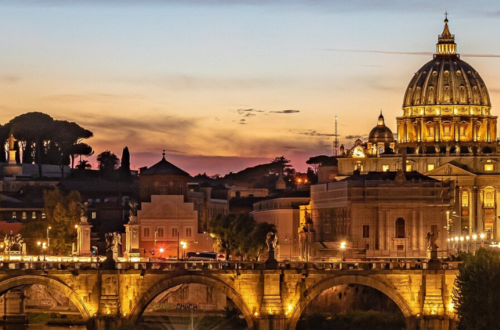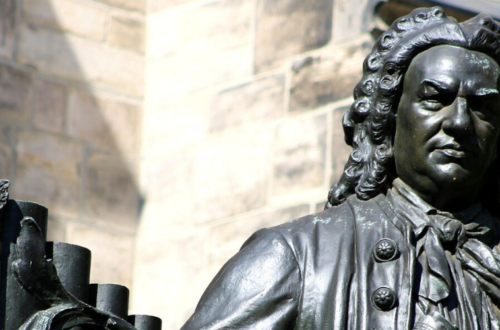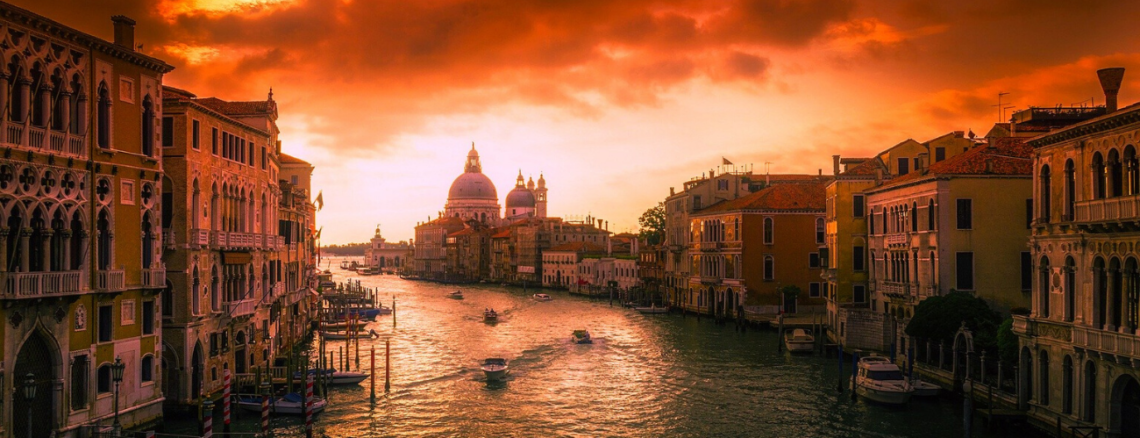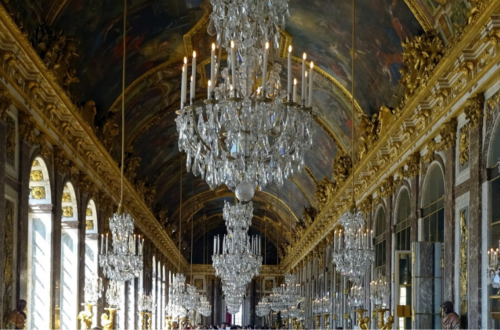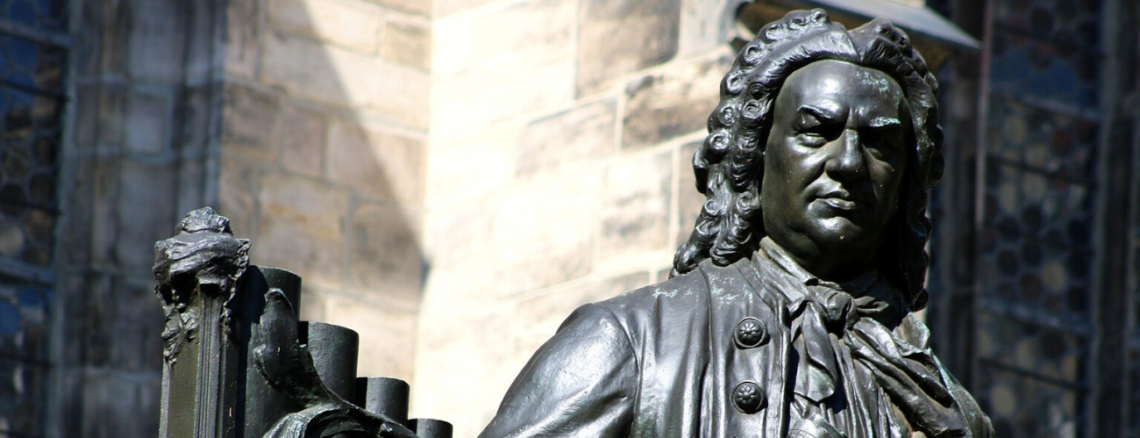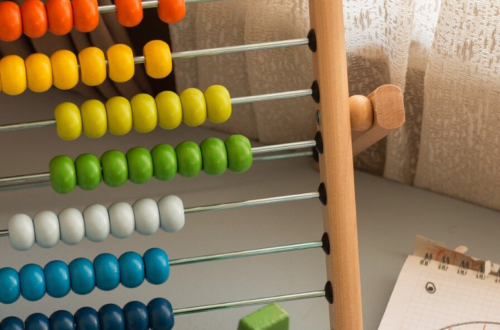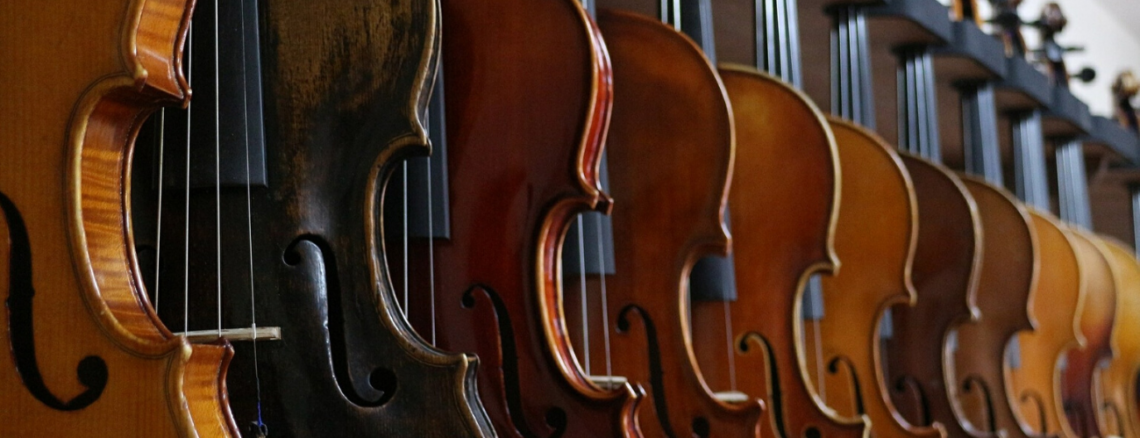-
Being Raucous with Royer, or Baroque Music for Kids at Home

I can’t help myself. Whenever I read an article about how calm and soothing classical music is, I think of pieces like Vertigo by Joseph-Nicolas-Pancrace Royer (c1705–1755), which is anything but. If you want to share some exciting Baroque music with your kids while you’re stuck at home, check out this piece by Royer!
Vertigo is the kind of crazy cool music that was happening in France between the 1730s and 1750s, at the end of the Baroque period (roughly 1600–1750). It is fire, it is fury. These are emotions that kids should be exposed to in music, too.
This music is anything but relaxing, but that’s what makes it so great. I think its intensity is part of what draws my one-year-old son, Little M, to it. Hopefully your children will be drawn to it, as well, and will find it as interesting as Little M does.
Before we get to the music, here’s a short bio about Royer to get you up to speed.

Royer’s Bio
Joseph-Nicolas-Pancrace Royer (c1705–1755) was a French composer during the late Baroque period of classical music. In addition to being a composer, he also played the harpsichord and organ and was known for being a great musician. He worked at various musical locations in Paris, as well as at the French court at Versailles.
Royer is best remembered (when he’s remembered at all) for his harpsichord music. But he actually wrote a lot of operas, which are like plays but with singing instead of speaking. He was a very well-known musician during his lifetime even though he has mostly been forgotten today.
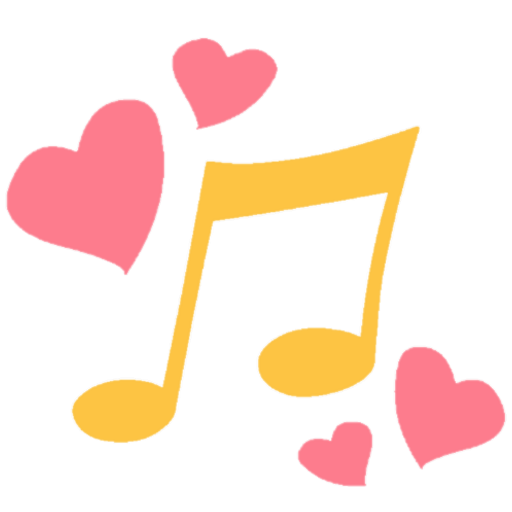
The Music
As promised, the selection my son, Little M, and I wish to share with you today is Royer’s Vertigo. This music is great to share with your kids at home because it is not only interesting to listen to but also fascinating to watch. My son is very intrigued by the harpsichord and its unique sound, so he finds pieces like this fascinating.
While we’re on the topic, a few notes about the harpsichord, which is the only instrument in today’s video. Despite its appearance, the harpsichord is not very much like the piano. The technique used to play it and make it sound its best is completely different from piano technique. The unique sound of the harpsichord is created by little pieces of bird quill–like the part of a bird feather people used to write with!–plucked the strings when the keys are played.
If you want to learn more about the harpsichord and how it’s different from the modern piano, check out our Guide to Baroque Instruments.
This music was intended to shock and amaze and I think it does that as much for the player as it does for the audience. It’s full of devilish surprises that challenge the harpsichordist’s technique and the listener’s ear. It is virtuosic harpsichord music.
The fabulous harpsichordist in this video is Jean Rondeau. Go check out his website or his YouTube channel! A bunch more videos of his playing can be found on the Warner Classics YouTube channel.
If you want to check out the whole CD, you can find it on Amazon by clicking the image below. (Disclaimer: We may receive compensation [at no extra cost to you!] when you click on the links to this CD.)
-
Vivaldi and Violins, or Baroque Music for Babies

In today’s exploration of Baroque music that’s great for babies and children, my son, Little M, and I would like to share a piece with you by Antonio Vivaldi (1678–1741). You might already know about Vivaldi and his most famous work, a set of violin concertos called “The Four Seasons,” or Le quattro stagioni.
Vivaldi wrote more than 500 hundred concertos–pieces for a solo instrument, or group of soloists, and orchestra–and nearly half of those are for violin. But that’s not all that he’s known for. Here’s a short Vivaldi bio to give you some more info.
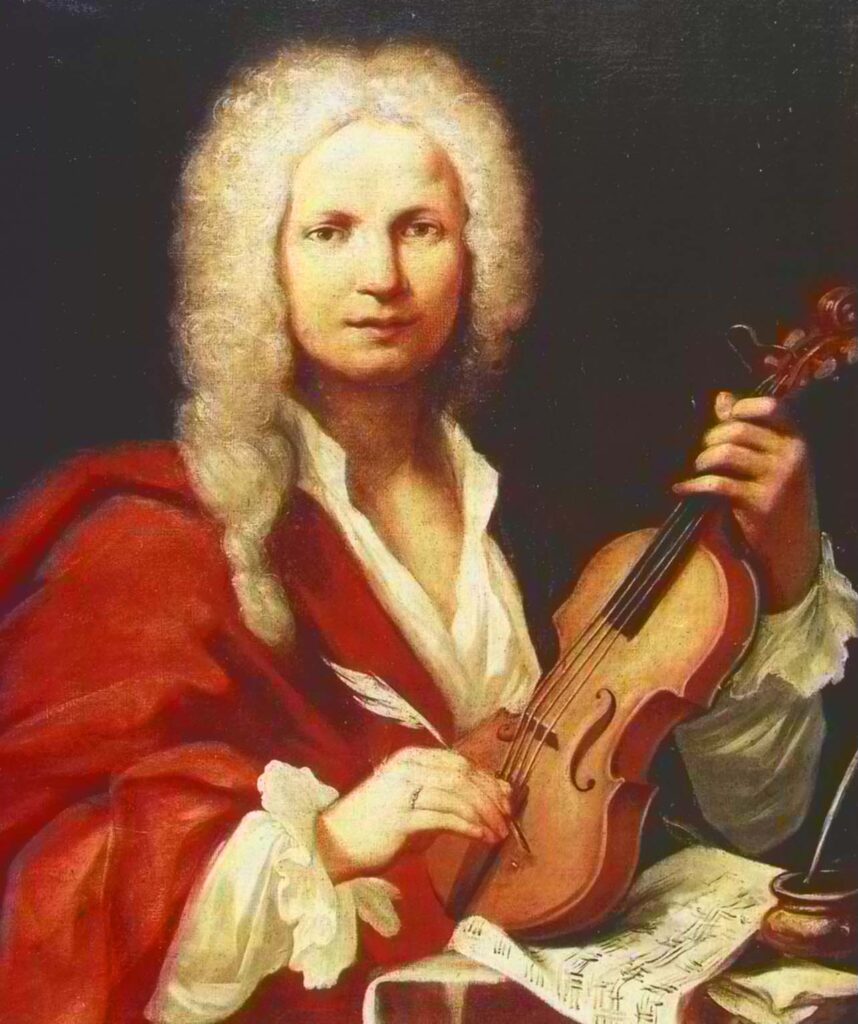
Vivaldi’s Bio
Vivaldi was known as “The Red Preist” because he had red hair and was. . . you guessed it. . . a Catholic priest. He was an Italian composer, born in Venice, Italy, in 1678, and he spent most of his life working at an orphanage there: the Ospedale della Pietà.
At the Ospedale he was in charge of an all-female musical ensemble, which consisted of an orchestra and choir. His ensemble and the ensembles of the other orphanages in Venice were considered to be very good, so good, in fact, that travelers from all over Europe came to hear them.
Vivaldi wrote most of his music for this ensemble, including more than 60 vocal works such as his Gloria in addition to his 500+ concertos. But he also wrote nearly 50 operas and some other works for musicians outside of the Ospedale.
After his death in 1741, his works were mostly forgotten until they were “rediscovered” in the 1920s and 30s and started to be programmed again on concerts.

The Music
The piece we want to share with you is from Vivaldi’s L’estro armonico (1711), which is an important published collection of concertos for one, two, and four violins with string orchestra. This piece is the third movement of the eighth concerto in that collection.
A movement is a [usually] short piece that is grouped together with other pieces to form a larger, complete piece.
It’s fast and furious, but also has tender moments that show the expressivity of the violins. Baroque music with these qualities is good for babies and children because it can hold their attention while also furthering their emotional development.
If you want to know more about any of the instruments you’re seeing, check out our Guide to Baroque Instruments. The instruments in this video are called “period instruments” because they were made at the same time period (i.e. hundreds of years ago!) as the music being played, or they are exact copies of instruments from that time period.
We hope you enjoy the music! Let us know what you think by leaving a comment below!
This performance is by the Irish Baroque Orchestra. Go check them out on their website or their YouTube channel!
-
Beginning with Bach, or Bach for Babies

There’s no better place to begin learning about Baroque music than with Johann Sebastian Bach (1685–1750)–he’s a famous classical music composer who is great for babies, children, and pretty much everyone else! Even though my one-year-old son, Little M, is just a baby, he loves Bach! And Bach is such a big deal that you’ve probably already heard of him, even if you’ve never listened to classical music before.
Spoiler Alert: You’ve actually already heard a lot of classical music in your life, even if you don’t know it! It’s in commercials and movies, in shopping malls and sometimes even elevators. You’ve almost definitely heard a lot more classical music than you think you have!
But who was Bach? And how did he become so famous? Here’s a short Bach bio to fill you in.
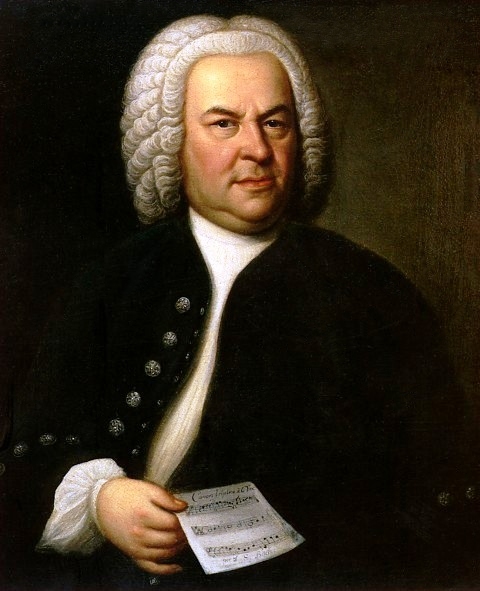
Bach’s Bio
J.S. Bach was born in Eisenach, Germany, in 1685. He started studying music at a very young age and even though both of his parents died by the time he was 10 years old, one of his brothers took care of him and helped him continue studying music.
As Bach grew up, he moved around to a few different cities in Germany, working as a musician everywhere he went. In 1723 he ended up in Leipzig, working as the music director for several churches there and teaching in the St. Thomas boys’ school. The move to Leipzig was the last one he made: he lived and worked there until his death in 1750.
Bach wrote more than 1,000 pieces that still survive today (and probably many more that no longer exist). He wrote both instrumental music–or music for instruments without voices–and vocal music–or music that includes singing.
Though he wasn’t super well-known during his lifetime, in the early 1800s–nearly 100 years later!–another composer, Felix Mendelssohn (1809–1847) thought his music was pretty amazing. Mendelssohn wanted more people to know about Bach’s music, so he put on a big Bach concert and that was the beginning of Bach’s fame. After that everyone saw just how great Bach’s music was and the rest is history.

The Music
So the piece of music my one-year-old son, Little M, and I want to share with you today is the first movement of one of Bach’s cantatas, “Wir danken dir…” (BWV 29).
A movement is a short(ish) piece that is grouped with other movements to form a larger musical piece. A cantata, in this context, is a piece of music for voices and instruments.
Even though this is a cantata (so it has singers), the first movement is just instruments, so you don’t need to worry about understanding any text.
This movement is fun and flashy and really enjoyable to watch as well as listen to! This is one of the reasons that Bach is great for babies–his music is often good at capturing their attention, especially with great performance videos!
If you want to know more about any of the instruments you see in the video, check out our Guide to Baroque Instruments. The instruments in this video are called “period instruments” because they were made in the same time period (i.e. hundreds of years ago!) as the music being played, or they are exact copies of instruments from that time period.
We hope you enjoy the music! The first movement ends at about 3:50, so you can stop the video there or keep listening if you want to hear more. Let us know what you think by leaving us a comment below!
This performance is by the Netherlands Bach Society. Go check them out on their website or their YouTube channel!
-
5 Reasons Why Your Children Should Listen to Classical Music

While experts are divided on whether or not listening to classical music actually makes babies and children smarter, here are five reasons why your kids (and you) should be listening to it anyway.
1. It’s exciting!
Articles about the childhood benefits of classical music often emphasize its soothing qualities, but that’s just one small part of what classical music is. Classical music can be anything you want it to be if you know where to look, from joyful to heartbreaking to calming and even inspiring. In fact, one of the main goals of classical music has always been to express and evoke intense emotions! This can help to further a child’s emotional development.
2. It’s social.
Even if you’re stuck at home, watching or listening to classical music can be a group activity. You and your kids can watch performances and talk about what you see and hear. You can have a dance party in your living room to some classical music with a great beat! Or you could even put on classical music in the background while you play with your baby or do some other activities with your kids. There are endless possibilities for interaction involving classical music.
3. It’s educational.
Classical music brings a lot to the table in terms of education. You and your kids could learn about instruments and the different sounds they make. Or maybe you are more interested in history: there are hundreds of years of sounds and stories to discover. Exploring classical music might even inspire your child to learn an instrument, which comes with endless developmental benefits including enhanced memory, better coordination, and stronger complex reasoning skills.
4. It’s something new.
New experiences help babies and children (and everyone else) learn about the world around them. This furthers their cognitive and emotional development and makes their lives richer, even from an early age. And even if you’ve listened to some classical music in the past, you can never run out of new pieces and styles. There are endless exciting classical music experiences awaiting you!
5. It’s budget-friendly.
While live concerts are the ideal way to experience classical music and support classical musicians, it is easy to begin exploring and enjoying classical music from your own home. Hundreds of thousands of hours worth of pre-recorded performances and albums can be found on YouTube, and even more-obscure composers and pieces are often on Spotify, iTunes, or other online music services. High-definition performance recordings can also be visually captivating so finding the perfect piece to turn a bored child into an occupied one is often just a (free) click away!
Classical music has so much to offer on so many different levels. I enjoy classical music (as a performer and a listener) because I find it both engaging and enriching: it makes my life happier and more interesting. I also like sharing classical music with my one-year-old for these same reasons. He has a great time listening and learning!

Here are three musical works from my specialty, Baroque music (What’s “Baroque music”? Find out here.), to get you started.
1. “Dopo lungo penare” by Luigi Rossi
Find out more about Luigi Rossi and this piece here.
2. Concerto for Two Violins in a minor, Op.3, No.8, RV 522: III. Allegro by Antonio Vivaldi
Find out more about Antonio Vivaldi and this piece here.
3. Cantata “Wir danken dir…”, BWV 29: First Movement by Johann Sebastian Bach
The first movement ends at about 3:50, so you can stop the video there or keep listening if you want to hear more!
Find out more about Johann Sebastian Bach and this piece here.
If you want to learn more about the instruments you see in these videos, check out our Guide to Baroque Instruments.


